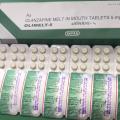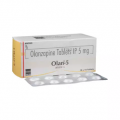Home / Categories / OLZAP-5MG

OLZAP-5MG
(10)
OLANZAPINE-5MG
ANTI-PSYCHOTICS
NEPAL PHARMACEUTICAL LAB-LAPEN DIVISON
Product Details
| Olanzapine |
| (oh-LAN-zah-peen) |
| Zyprexa |
| Tablets: 2.5 mg |
| Tablets: 5 mg |
| Tablets: 7.5 mg |
| Tablets: 10 mg |
| Tablets: 15 mg |
| Zyprexa Zydis |
| Tablets, orally-disintegrating: 5 mg |
| Tablets, orally-disintegrating: 10 mg |
| Tablets, orally-disintegrating: 15 mg |
| Tablets, orally-disintegrating: 20 mg |
| Class: Atypical antipsychotic |
 Actions Unknown. May control psychotic symptoms through antagonisms of selected dopamine and serotonin receptors in the CNS.
Actions Unknown. May control psychotic symptoms through antagonisms of selected dopamine and serotonin receptors in the CNS.
 Indications Treatment of schizophrenia; short-term treatment of acute manic episodes with bipolar I disorder.
Indications Treatment of schizophrenia; short-term treatment of acute manic episodes with bipolar I disorder.
Dementia related to Alzheimer disease.
 Contraindications Standard considerations.
Contraindications Standard considerations.
Schizophrenia: ADULTS: PO Start with 5 to 10 mg/day and adjust dosage at 5 mg increments in intervals of greater than 1 wk (safety of doses at least 20 mg/day have not been evaluated). Biopolar Mania: ADULTS: PO Start with 10 to 15 mg/day and adjust at 5 mg increments in intervals greater than 24 hr (safety of doses more than 20 mg/day have not been evaluated). Special Populations: ADULTS (eg, debilitated, predisposed to hypotension, elderly): PO Start with 5 mg daily.
Antihypertensive drugs: Olanzapine may enhance hypotensive effects. Carbamazepine: 50% increase in olanzapine clearance resulting in lower plasma levels. Fluvoxamine: May elevate olazapine plasma levels. Sedating drugs and alcohol: Additive CNS depression; motor and cognitive impairment. Levodopa and other dopamine agonists: Olanzapine may antagonize their effects by inhibiting dopamine receptors.
 Lab Test Interferences None well documented.
Lab Test Interferences None well documented.
CARDIOVASCULAR: Hypotension; tachycardia. CNS: Somnolence; agitation; insomnia; nervousness; hostility; akathisia; amnesia; impairment of articulation; euphoria; stuttering; tardive dyskinesia; anxiety; twitching. DERMATOLOGIC: Rash. EENT: Amblyopia; blepharitis; corneal lesion. GI: Constipation; dry mouth; salivation; nausea; vomiting; increased appetite. GU: Premenstrual syndrome; hematuria; metrorrhagia; urinary incontinence. HEPATIC: Increased LFTs. METABOLIC: Weight gain; peripheral edema; lower extremity edema. RESPIRATORY: Rhinitis; cough; pharyngitis; dyspnea. OTHER: Headache; flu-like syndrome; fever; dizziness; joint and muscle aches.
Pregnancy: Category C. Lactation: Undetermined. CHILDREN: Safety and efficacy not established. Body temperature regulation: Antipsychotics disrupt the ability to reduce core body temperature. Use with caution in patients who will experience conditions that may contribute to an elevation in core body temperature (eg, strenuous exercise, exposure to extreme heat, concomitant anticholinergic therapy, subject to dehydration). Dysphagia: Use with caution in patients at risk for aspiration pneumonia. Hepatic dysfunction: Use with caution. Hyperprolactinemia: Olanzapine-treated patients often have elevation in prolactin levels; however, there is no evidence of increased breast tumor risk. Liver disease: Monitor LFTs in patients with significant hepatic disease. Neuroleptic malignant syndrome (NMS): NMS has occurred and is potentially fatal. Signs and symptoms are hyperpyrexia, muscle rigidity, altered mental status, irregular pulse, irregular BP, tachycardia, and diaphoresis. Orthostatic hypotension: May occur with associated symptoms of dizziness, tachycardia, and syncope. Most common during titration period and in patients with CV disease, cerebrovascular disease, and conditions which predispose to hypotension (eg, dehydration, hypovolemia, treatment with antihypertensive agents). Reduce risk by initiating therapy with 5 mg qd. Seizures: Use with caution in patients with a history of seizures or with conditions that lower the seizure threshold (eg, Alzheimer disease, dementia). Tardive dyskinesia: Syndrome of potentially irreversible, involuntary dyskinetic movements may develop. Prevalence is highest in elderly, especially women. Use smallest effective dose for shortest period of time needed.
| PATIENT CARE CONSIDERATIONS |
|
- Administer qd without consideration of meals or food.
- Store at room temperature. Protect from light and moisture in tightly closed container.
- Administer disintegrating tablet by peeling back foil on blister pack (do not push tablet through foil) and, using dry hands, remove tablet from foil and place in patient's mouth; tablet will disintegrate with or without liquid.
- Obtain patient history, including drug history and any known allergies. Note history of neuroleptic malignant syndrome, seizures, and liver disease. Note current use of hypertensives.
- Ensure that LFTs are checked periodically in patients with liver disease.
- Monitor for symptoms of NMS, including hyperpyrexia, muscle rigidity, altered mental status, and evidence of autonomic instability (eg, irregular pulse, tachycardia, diaphoresis, cardiac dysrhythmia), elevated creatinine phosphokinase, myoglobinuria (rhabdomyolysis), and acute renal failure.
- Evaluate potential for cognitive and motor impairment, especially somnolence.
- Assess for exposure to conditions that may contribute to an elevation in body temperature, including strenuous exercise, exposure to extreme heat, or conditions that may cause dehydration.
- Monitor patients at risk for aspiration pneumonia.
- Monitor patients with a history of seizures or conditions that potentially lower the seizure threshold such as Alzheimer disease or dementia.
- Monitor patients for orthostatic hypotension and employ fall prevention precautions.
- Monitor patient for signs and symptoms of tardive dyskinesia.
- Monitor high-risk patients for suicide attempts especially those with schizophrenia. Assess for potential hoarding of pills and other at-risk behaviors.
|
||||
- Instruct patient to take olanzapine exactly as directed and to not discontinue or change the dose unless advised to do so by health care provider.
- Inform patient or family that several weeks of treatment may be required to obtain the full therapeutic effect, and to take the medication exactly as prescribed.
- Advise patient that drug may cause drowsiness, and to use caution while driving or performing tasks requiring mental alertness.
- Instruct patient to avoid intake of alcoholic beverages or other CNS depressants.
- Instruct patient not to take OTC medications without consulting health care provider.
- Instruct patients to report the following symptoms to health care provider: irritability, agitation, changes in vision, headache, dizziness, somnolence, insomnia, nervousness, hostility, mental problems.
- Instruct women to notify health care provider if pregnant or planning to become pregnant.
- Advise patient not to breastfeed while taking this medication.
- Instruct patient to avoid becoming overheated.
- Instruct patient to report involuntary face, tongue, mouth, or lip movements to health care provider.
- Caution patient to avoid sudden position changes to prevent orthostatic hypotension.
- Remind patient to dress warmly in cold weather and avoid extended exposure to either very hot or cold temperatures, as body temperature is harder to maintain with this drug.
- Reinforce necessity of follow-up examinations and continued therapy.
Books@Ovid
Copyright © 2003 Facts and Comparisons
David S. Tatro
A to Z Drug Facts
Substitutes

 Route/Dosage
Route/Dosage Interactions
Interactions Adverse Reactions
Adverse Reactions Precautions
Precautions Administration/Storage
Administration/Storage Assessment/Interventions
Assessment/Interventions Patient/Family Education
Patient/Family Education
